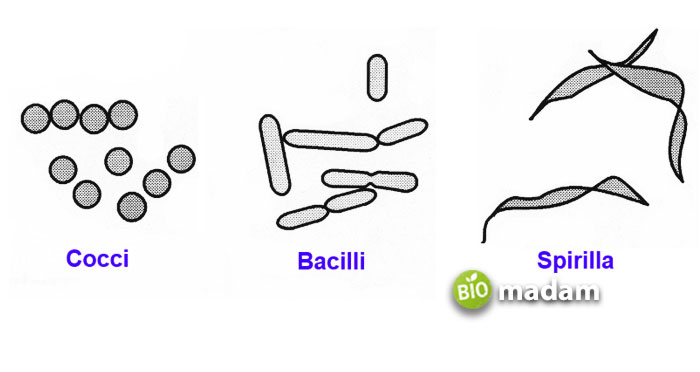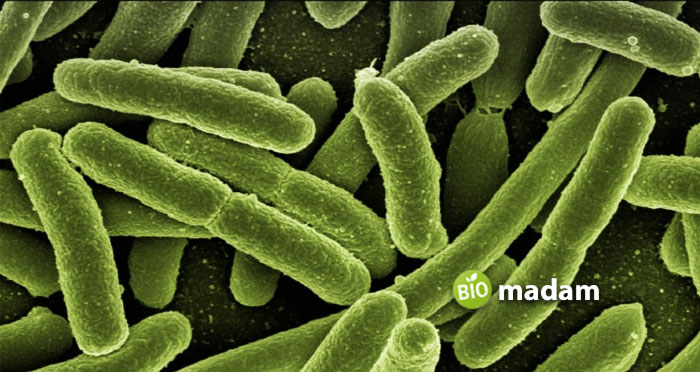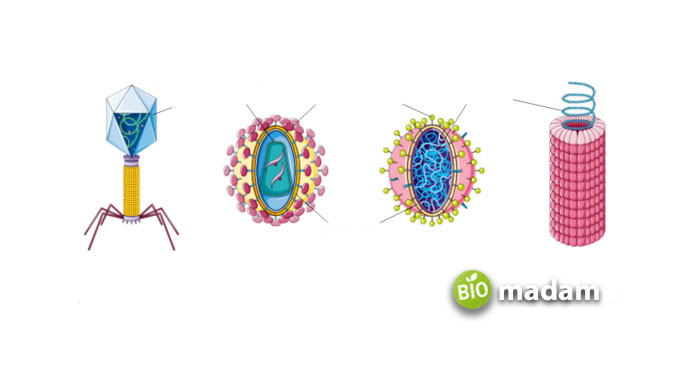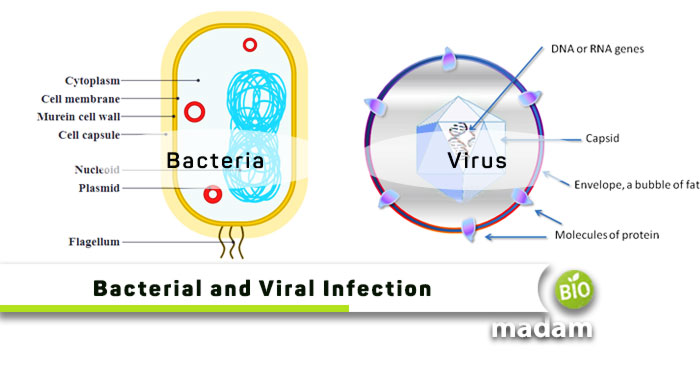Recently updated on December 31st, 2025 at 01:09 pm
Bacteria and viruses are microscopic organisms present all around us. As they are microscopic, we cannot see them; yet they are everywhere – yes, inside us as well!
Some bacteria are considered “good bacteria” as they do not harm us despite living inside our bodies. However, mostly, bacteria and viruses cause infections and diseases. Bacterial infections are caused by bacteria, whereas viruses cause viral infections. You can see them under a compound or electron microscope. Viruses are not visible under compound microscopes though.
Besides this evident dissimilarity, there are several differences between bacterial and viral infections. Let’s study them thoroughly.
Comparison Table
| Characteristic | Bacterial Infection | Viral Infection |
| Causative Agent | Bacteria | Virus |
| State | Living | Non-living |
| Need for host | No | Yes |
| Treatment | Antibiotics | Antivirals |
| Vaccination | No | Yes |
| Examples | Pneumonia, and Meningitis | Influenza, AIDS |
Bacterial Infections
Bacterial infections are caused by bacteria that live in our surroundings and cause disease when they enter the body. Bacteria are unicellular prokaryotic organisms with microscopic bodies that can be seen with an electron, compound, or student microscope. They can easily invade the body through any of the orifices during breathing or ingesting food. While some bacteria in our small and large intestines help keep the gut healthy, most bacteria harm the body somehow.
Types of Bacterial Infections
Bacteria are divided into two types majorly; gram-negative and gram-positive. Gram-positive bacteria have a thick cell wall but lack an outer cell membrane. Thus, they do not take the violet stain of the dye and are stained with a counterstain. On the other hand, gram-negative bacteria give purple stains with the dye. Gram-negative bacteria are more resistant than gram-positive. They are typically found in three shapes; bacilli, cocci, and spirilla.

Mechanism of Bacterial Infections
When bacteria enter your body, they bind to the epithelial layer of cells to initiate responses in the cell. Each type of bacteria possesses a particular set of molecules that attack a particular region like Mycobacterium tuberculosis cause Tuberculosis, while H. Pylori causes dysentery; you may not see a person having breathing issues or an eye infection caused by H. Pylori.
Once they invade the cell, different pathogens, having a set of antigens, act in their specific way by releasing toxins to damage the host. Some of these parasitic organisms are proteolytic and break down the host proteins causing harm to the host cell, and others are membrane-disrupting toxins that cause lysis of the cell membrane.
Examples of Bacterial Infections
Bacterial infections are classified into numerous depending on their site of action. Some of the common bacterial infections are:
Tuberculosis (TB) is caused by Mycobacterium tuberculosis and occurs in the lungs. It is a gram-positive bacteria
Cholera affects the digestive system and is caused by Vibrio cholera. It is a gram-negative bacteria.
Typhoid harms the intestines and is caused by Salmonella typhi, a gram-negative bacteria.
Pneumonia is another infection of the lungs caused by Streptococcus pneumonia which is a gram-positive bacteria.
Urinary Tract Infections (UTIs) are also caused by a bacteria called Escherichia coli. It is a gram-negative bacteria and causes urinary tract issues in men and women.
Other bacterial infections include otitis media, dysentery, gastritis, bacterial meningitis, bacterial encephalitis, STDs, skin and eye infections, etc.
Bacterial Infection Symptoms
It is quite difficult to differentiate between bacterial and viral infections through the signs and symptoms, yet you must consult your doctor if any of them appear to get adequate treatment timely.
- Headache
- Fever
- Chills
- Pain
- Exhaustion
- Disturbed GI (nausea, vomiting, diarrhea)
Bacterial Infections Treatment
If probiotics fail to help a body in most bacterial infections, antibiotics are used. Antibiotics are specifically designed for gram-negative and gram-positive bacteria. As some bacteria get resistant to these antibiotics, then broad-spectrum antibiotics are used that can kill a wide range of bacteria causing various diseases.
Antibiotics are majorly divided into two types; bacteriostatic and bacteriocidal. Bacteriostatic antibiotics halt the activity of the bacteria by alternating their structure, whereas bacteriocidal antibiotics kill them completely. As you may develop resistance to antibiotics, it is important not to take them without understanding the causative agent.
Some common examples of antibiotics are Penicillin (acts on gram-negative), Erythromycin (acts against gram-positive), and Doxycycline (broad-spectrum antibiotics).

Viral Infection
Viral infections are caused by viruses and typically go away when they complete their cycle. One of the fundamental differences between bacterial and viral infection is the ability of viruses to survive antibiotics. For a long time, it was thought that antibiotics were also suitable for killing viruses besides bacteria and fungal infections. Yet, studies showed that viral infections could not be treated with antibiotics.
Viruses are microscopic organisms that need a living host to multiply. Some viruses like HIV are deadly and not easily treatable. In contrast, others like the cold virus are quite common, with millions of people getting flu at least once a year. They may enter your body through orifices, blood transfusion, saliva, semen, or feces.
Types of Viral Infections
Different viruses cause specific diseases; they are typically classified on their pathogenic function and named accordingly. However, like other pathogens, viruses come in various shapes and forms, two most prominent of which are helical and icosahedral.
Helical viruses have a capsid inside a rod-shaped filamentous structure with nucleic acid present in the center. On the other hand, an icosahedral virus contains identical subunits that arrange in a symmetrical form to create equilateral triangles.

Mechanism of Viral Infection
A viral infection consists of a cycle of six steps. The steps are attachment, penetration, uncoating, gene expression, assembly, and release.
Attachment
The first step of the virus cycle is attachment. It is the first encounter of the viruses with host cells. They attach to the attachment factors on the cell.
Penetration
After attachment, the next step is penetration, where the virus penetrates the cytoplasm. It occurs through two mechanisms depending on whether the virus is enveloped. The two possible mechanisms of penetration are direct fusion and receptor-mediated endocytosis (a type of pinocytosis).
Direct fusion occurs by binding the cell membrane and the viral envelope. At the same time, receptor-mediated endocytosis involves the formation of a coated pit on the cell membrane resulting in an endosome. The endosome is broken down depending on whether the viral has an envelope. Most viruses penetrate the cytoplasm by receptor-mediated endocytosis.
Uncoating
Following attachment and penetration, the viral genome uncoats and exposes itself to the cell for gene expression and replication.
Gene Expression and Replication
Each virus family has a distinct gene expression and replication that gives it a particular identity. The gene expression depends on the host translation machinery, protein synthesis, and ribosomes.
Assembly
The assembling of the viral capsid consists of two processes; genome packaging and capsid packaging. One or both processes may occur depending on the kind of virus.
Release
The release is the second part of the exit process. The particles of unenveloped viruses are released through cell lysis, whereas enveloped viral particles have a lipid layer outside the capsid before release.
Examples of Viral Infection
Some of the common viral infections are:
Influenza is caused by the Influenza virus and affects the respiratory system resulting in flu-like symptoms.
Herpes results from the entry of the herpes simplex virus (HSV) into the body and causes blisters.
The Human immunodeficiency virus (HIV) causes AIDS (Auto Immuno Deficiency Syndrome) and diminishes the immune system.
Rhinovirus, adenovirus, and coronavirus cause the Common cold.
Polio is caused by poliovirus, which results in partial body paralysis of the lower torso.
Other viral infections include Ebola, Hepatitis C, Dengue fever, Mumps, Rubella, Zika virus, and viral conjunctivitis.
Viral Infection Symptoms
Typically the symptoms of a viral infection are similar to a bacterial infection, including a Runny nose
- Congestion
- Sore throat
- Chills
- Fever
- Body aches
Viral Infections Treatment
Viral infections are not treatable through antibiotics and require antivirals. However, they do not treat all viruses, and many times you have to wait for the virus to complete its cycle and leave the body on its own. Vaccines are administered globally to prevent viral infections that do not have a treatment. The most commonly given vaccines for viral infections include the Polio vaccine and MMR vaccine for Mumps Measles-Rubella.

Similarities Between Bacterial and Viral Infections
- Bacterial and viral infections both can occur in living organisms due to microorganisms, like bacteria and virus.
- They show similar symptoms like cough, chills, fever, etc.
- Viral and bacterial infections are typically contagious like tuberculosis, and AIDS.
Difference between Bacterial and Viral Infection
Causative Agent
Bacterial Infection
Bacterial Infections are caused by bacteria.
Viral Infection
Whereas viral infections are caused by viruses.
State
Bacterial Infection
Bacteria are considered living organisms.
Viral Infection
Conversely, viruses are typically called non-living organisms as they require a host.
Role
Bacterial Infection
Bacteria may be good or bad bacteria. Good bacteria help regulate body functions, while bad bacteria cause infections.
Viral Infection
All viruses cause viral infections; some may be more severe than others.
Need for Host
Bacterial Infection
Bacteria do not require a host to multiply.
Viral Infection
Viruses use their host as a site for replication, and it is one of the parts of the virus lifecycle inside the host.
Treatment
Bacterial Infection
Alternatively, bacterial infections ruses are treated with antibiotics like Erythromycin, Cephalosporins, etc.
Viral Infection
Viral infections are sometimes treated using anti-virals.
Vaccination
Bacterial Infection
Bacterial infections cannot be prevented through vaccination, but antibiotics are always needed.
Viral Infection
On the contrary, you can prevent viral infections by vaccinating against the virus.
Examples
Bacterial Infection
Some common examples of bacterial infections are meningitis, pneumonia, tuberculosis, etc.
Viral Infection
Common examples of viral infections are herpes, AIDS, cold, etc.
FAQs
What are good bacteria?
Good bacteria, also known as probiotics, live in your gut and help keep you healthy. They primarily help your body get rid of bad bacteria and maintain a healthy balance.
How many days should I take antibiotics?
Antibiotics must be used as per the prescription by the healthcare professional. Always complete the antibiotic course to knock off the bacteria, or it may cause disease again.
Is AIDS curable?
Most viral infections, including AIDS, are not curable. However, you can manage AIDS by taking proper care and preventing the transmission of HIV to others.
The Bottom Line
Viral and Bacterial infections are quite common and caused by microorganisms. Both present similar symptoms and can be transmitted through multiple means from one person to another. However, the treatment of bacterial and viral infections is quite different from each other. Bacteria can be killed using antibiotics, but antivirals do not destroy all viruses, and some exit the body after completing their cycle. Always be sure to avoid transmission, whether you have a bacterial infection or viral, and take medication per the physician’s recommendation.

Meet me; I am Paulina Zaniewska, who’s more hooked on providing the best health blog. I’ve always been so determined to compete as a nutritionist, and here I am, done with a Master’s in food technology. My brilliant performance throughout encouraged me to help people.

